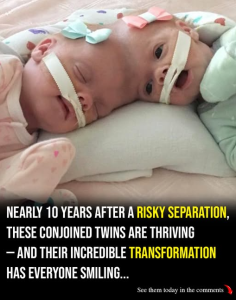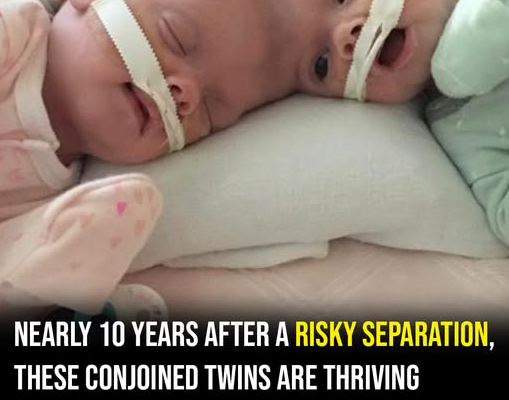
When Erin and Abby Delaney were born in July 2016, the world did not yet know their names, but their arrival immediately captured the attention of doctors, specialists, and eventually millions of people around the globe. They came into life as craniopagus twins—conjoined at the head—one of the rarest and most complex forms of conjoining, occurring in perhaps one in 2.5 million births. For their parents, Heather and Riley Delaney of North Carolina, the diagnosis had arrived during pregnancy, bringing with it fear, uncertainty, and a rapidly growing understanding that their daughters’ future would be defined by extraordinary medical challenges. But what no one yet knew was that their story would also become one of the most remarkable triumphs in pediatric medical history.
From the moment of their birth, Abby and Erin began life not in an ordinary nursery but in the neonatal intensive care unit, surrounded by monitors, specialists, and constant supervision. Because they were connected at the top of their heads, their skulls and blood vessels were intertwined. This made even the simplest movements—turning, feeding, positioning—difficult and potentially dangerous. Doctors at the Children’s Hospital of Philadelphia (CHOP), one of the world’s leading centers for conjoined twin separation, were contacted almost immediately. The family soon made the decision to relocate so their daughters could be under the care of the hospital’s team and begin the long road toward the possibility of surgical separation.
The decision to separate twins conjoined at the head is never made lightly. Craniopagus separation is among the most dangerous operations in modern medicine, requiring years of planning, dozens of specialists, advanced imaging, and painstakingly detailed surgical simulations. The risk of death or severe neurological damage is significant. But the Delaneys had hope, and the medical team believed that with careful preparation, Abby and Erin had a real chance.
In the months before the surgery, the twins underwent a carefully staged process designed to prepare their bodies for separation. Surgeons placed custom tissue expanders—balloon-like devices beneath the skin of their scalps—to slowly stretch the skin and allow enough coverage for two separate skulls after separation. Every procedure, every expansion, every scan was part of the larger choreography leading toward the main operation. Heather and Riley watched their daughters grow, facing each day with both gratitude and fear, knowing each milestone brought them closer to the moment that would shape the rest of their lives.
On June 6, 2017, after nearly a year of planning, more than twenty surgeons and dozens of nurses, anesthesiologists, and technicians entered CHOP’s operating theater to perform the surgery that would change Abby and Erin’s lives. The operation lasted more than 11 hours. Teams rotated through phases: separating bone, dividing shared blood vessels, reshaping skull structures, and reconstructing the girls’ heads. The complexity was staggering. Using 3D models and pre-surgical planning software, the team mapped every cut before stepping into the operating room.
One of the most delicate portions involved the sagittal sinus, one of the brain’s major veins, which the girls shared. Surgeons had to decide how best to divide it so that both children could survive, weighing blood flow needs, pressure changes, and minute anatomical differences. Every decision mattered. Every move carried risk.
Finally, after hours of intense focus, the moment arrived. The girls, once connected, were gently placed on separate operating tables. For the first time in their lives, Abby and Erin were two individuals—two patients, two futures, two hearts that had always beaten together but were now ready to move forward on their own.
The aftermath of the separation brought its own challenges. Recovery was slow, demanding, and at times frightening. Each twin faced unique medical needs, including further operations to reconstruct their skulls, therapies to support motor and cognitive development, and constant monitoring. But they also experienced tremendous progress. Their personalities began to emerge more distinctly. Abby, energetic and expressive, brought a lively spark to her therapy sessions. Erin, thoughtful and observant, charmed everyone with her quiet strength. Their bond remained deep and unmistakable—even if they no longer shared the same physical space.
Heather and Riley became not only caregivers but advocates. They shared updates, offering hope to families around the world navigating complex medical realities. Their gratitude to the medical team was boundless, but even more powerful was their faith in their daughters’ resilience. The family’s life revolved around appointments, therapy sessions, and developmental milestones, yet they celebrated each small victory with profound joy: a new word, a new movement, a shared giggle between sisters who had already survived so much.
As the twins grew older, their progress surprised even some of the doctors who once cautioned about possible developmental delays. While challenges remained—and always will, given the surgeries and neurological risks—they continued to surpass expectations. They learned to sit up, to play, to explore the world around them. Their bond remained as fierce as ever, rooted in a beginning far more intertwined than that of most siblings.
Their story resonated globally because it represents something larger than medicine alone. It is a story of courage—the courage of two infants who endured surgeries and recoveries before they could even speak; the courage of parents who faced impossible choices; and the courage of medical teams who pushed the boundaries of what is surgically possible. It is also a story of innovation, showcasing advances in imaging, surgical planning, and pediatric care that made a once-impossible separation achievable.
But most of all, the story of Abby and Erin Delaney is one of hope. A reminder that even in the face of overwhelming odds, human resilience can shine. That families can endure unimaginable uncertainty. That science and compassion can work hand in hand to create miracles.
Today, Abby and Erin continue to grow, learn, and thrive as individuals—each with her own personality, her own dreams, and her own path forward. Their journey is ongoing, and like all children, they will face new challenges and opportunities as they navigate school, friendships, and the world beyond the hospital walls. But they will do so as survivors, as sisters, and as living proof of what is possible when love, determination, and extraordinary medical skill come together.

